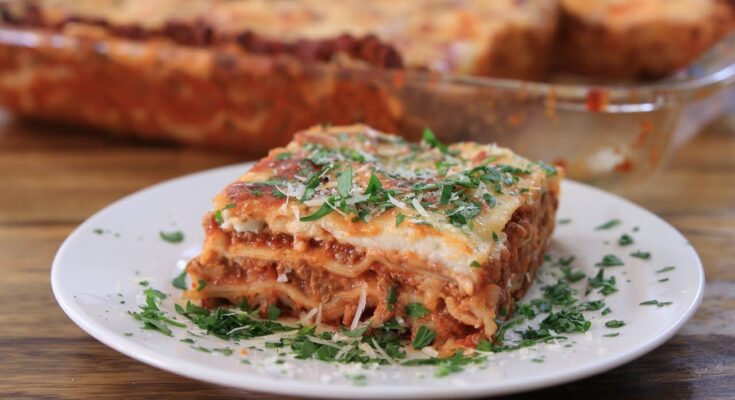Authentic Lasagna Recipe: Lasagna is one of those timeless dishes that brings comfort, warmth, and a slice of Italy into your kitchen. An authentic lasagna isn’t just a recipe – it’s a ritual. Passed down through generations, every step matters. From the slow-simmered ragù to the silky béchamel and layers of cheese, each element contributes to a lasagna that’s rich, flavorful, and unforgettable.
What Makes Lasagna Truly Authentic?
Authentic lasagna is all about quality and tradition. Unlike quick recipes that cut corners with jarred sauces or pre-shredded cheese, a genuine lasagna requires patience and fresh ingredients. The classic version, known as Lasagna alla Bolognese, originates from Bologna, Italy, and uses ragù (meat sauce), béchamel sauce, and Parmigiano-Reggiano cheese layered between sheets of fresh pasta.
What truly makes it authentic is the balance of flavors and respect for each ingredient. There’s no overload of cheese or random fillings – just a harmonious blend that allows every component to shine.
A Glimpse Into Italian Culinary Heritage
Lasagna isn’t just a meal in Italy; it’s an experience. Traditionally made for family gatherings or special occasions, the dish reflects Italy’s love for hearty, slow-cooked meals. Every region in Italy has its own take, but the Bolognese style remains the most celebrated worldwide. This version highlights the power of simplicity, using well-seasoned meat sauce, freshly made pasta, and creamy béchamel to create a comforting, soul-satisfying dish.
Ingredients You’ll Need
The Core Components
To make a truly authentic lasagna, you need to start with the right ingredients. Here’s what you’ll need:
- For the Meat Ragù:
- 2 tbsp olive oil
- 1 onion (finely chopped)
- 1 carrot (finely chopped)
- 1 celery stalk (finely chopped)
- 500g ground beef (or beef-pork mix)
- 1 cup red wine
- 800g crushed tomatoes
- Salt and pepper to taste
- For the Béchamel Sauce:
- 4 tbsp butter
- 1/4 cup all-purpose flour
- 3 cups milk
- Nutmeg, salt, and pepper to taste
- Other Essentials:
- Fresh lasagna pasta sheets
- Grated Parmigiano-Reggiano cheese
Best Types of Cheese and Pasta Sheets
Stick with Parmigiano-Reggiano for an authentic flavor. Avoid using mozzarella or ricotta in the Bolognese version. As for the pasta, fresh egg-based lasagna sheets are ideal. You can make them from scratch or buy fresh ones from Italian delis or specialty stores.
Optional Add-ons and Variations
If you want to personalize your lasagna, you can add a touch of red pepper flakes for heat or mix in pancetta into the ragù. However, for a truly authentic experience, keep it traditional. Let the basic flavors speak for themselves.
Prepping the Ingredients
Making the Perfect Meat Sauce (Ragù)
The ragù is the heart of any authentic lasagna. Start by heating olive oil in a large pan. Add the finely chopped onions, carrots, and celery – this combination is known as soffritto in Italian cooking. Sauté until softened, then add the ground meat. Cook until browned, breaking it apart with your spoon.
Next, pour in the red wine and let it reduce. This step deepens the flavor and tenderizes the meat. Add crushed tomatoes, a pinch of salt, pepper, and let the sauce simmer gently for at least 1.5 to 2 hours. The longer it simmers, the richer it becomes. Stir occasionally and taste-test for seasoning.
Crafting a Creamy Béchamel Sauce
The béchamel adds silkiness and a slight sweetness that balances the savory meat sauce. In a saucepan, melt butter over medium heat, then whisk in the flour to create a roux. Cook for a minute to eliminate the raw flour taste.
Gradually whisk in the milk, stirring continuously to avoid lumps. Let it thicken for about 10 minutes, then season with a pinch of nutmeg, salt, and pepper. It should coat the back of a spoon without being too thick.
Prepping Pasta Sheets – Fresh or Store-Bought?
Fresh pasta is preferred and gives your lasagna a delicate texture. If using fresh, blanch the sheets in boiling water for 30 seconds and transfer to a clean towel. Store-bought dried pasta sheets can be used, but cook them according to package instructions beforehand unless they’re no-boil.
Assembling the Lasagna
Layering Like a Pro
This is where the magic happens. Preheat your oven to 375°F (190°C). In a large baking dish, start with a spoonful of ragù to cover the bottom. Add a layer of pasta sheets, followed by more ragù, then béchamel sauce, and a generous sprinkle of Parmigiano-Reggiano.
Repeat the layers—pasta, ragù, béchamel, cheese—until all ingredients are used up, finishing with a layer of béchamel and cheese on top. Typically, 4 to 5 layers work best.
Tips for a Perfect Structure
Make sure your layers are even and don’t overload any one layer with too much sauce. Too much liquid can cause the lasagna to fall apart. Allow some breathing space at the top of the dish to prevent spillovers while baking. A perfectly layered lasagna holds its shape when sliced and reveals distinct layers of sauce, cheese, and pasta.
Baking the Lasagna to Perfection
Oven Temperature and Time
Now that your lasagna is beautifully layered, it’s time to bake. Preheat your oven to 375°F (190°C) if you haven’t already. Cover your lasagna with foil—this prevents the top from burning and helps it cook evenly. Bake it covered for 30 to 35 minutes. Then, remove the foil and bake for another 15 to 20 minutes to develop that golden-brown, cheesy crust that everyone loves.
You’ll know your lasagna is ready when the edges are bubbling, the top is browned, and your kitchen smells like a rustic Italian kitchen. For added precision, you can insert a knife in the center and see if it comes out hot.
Let it rest for at least 15 minutes after baking. This step is crucial! It allows the layers to set, making slicing and serving much easier without the lasagna falling apart.
How to Get That Golden Crust
The golden crust is the crown jewel of a perfectly baked lasagna. After you remove the foil during the last 15 minutes of baking, keep a close eye on the oven. For a more dramatic effect, turn on the broiler for the last 2–3 minutes, but be careful—not more than that, or it could burn.
Sprinkling extra Parmigiano-Reggiano on the top layer before this final bake enhances browning and gives a deliciously nutty finish.
Serving Suggestions
Ideal Side Dishes
Lasagna is rich and hearty on its own, but pairing it with the right sides can elevate the meal. Here are some classic Italian-style accompaniments:
- Garlic Bread: Crunchy on the outside, soft inside, and loaded with garlic and herbs.
- Fresh Green Salad: A simple arugula or mixed greens salad with a light vinaigrette balances the heaviness of the lasagna.
- Roasted Vegetables: Think zucchini, bell peppers, and eggplant—drizzled with olive oil and herbs.
- Antipasto Platter: For special occasions, serve an assortment of cured meats, olives, and marinated veggies to start.
These sides complement the lasagna without overpowering its rich, layered flavors.
How to Plate Like an Italian Chef
Plating is not just for fancy restaurants—it can add a bit of elegance to your homemade dish. Use a spatula to lift a neat slice of lasagna onto a warm plate. Garnish with a sprinkle of fresh basil or parsley and a touch of extra cheese on top. You can even drizzle a bit of balsamic glaze or olive oil on the side for added sophistication.
A glass of Chianti or Sangiovese wine pairs beautifully with authentic lasagna, bringing out the richness of the meat sauce and cheese.
Storage and Reheating Tips
Storing Leftovers Without Losing Flavor
Leftover lasagna can be just as delicious—if stored properly. Once the lasagna cools to room temperature, cover the dish with plastic wrap or transfer individual portions into airtight containers.
- Refrigerator: Store for up to 4 days.
- Freezer: Wrap tightly in foil and then in a freezer bag or airtight container. It will last for up to 3 months.
Make sure the lasagna is completely cooled before freezing to prevent ice crystals and preserve texture.
Best Reheating Methods
To reheat lasagna without drying it out:
- Oven (Best Method): Preheat to 350°F (175°C), cover the lasagna with foil, and bake for 20–25 minutes.
- Microwave: Place a slice on a microwave-safe plate, cover with a microwave-safe lid or wrap, and heat for 2–3 minutes. Add a splash of water before heating to keep it moist.
- Stovetop (For a Quick Fix): Place a slice in a covered skillet on low heat with a tablespoon of water. Heat until warmed through.
Avoid reheating lasagna more than once to maintain quality and safety.
Common Mistakes to Avoid
Overcooking the Pasta
One of the most frequent mistakes when making lasagna is overcooking the pasta sheets. If you’re using dried pasta, you might be tempted to boil it until it’s fully tender—but resist the urge! Overcooked pasta can become mushy after baking, especially since it absorbs more moisture from the sauces.
If you’re using dried sheets, cook them al dente (firm to the bite). If you’re going for no-boil sheets, ensure your sauces are slightly thinner so they have enough moisture to cook the pasta during baking. For fresh pasta, blanching for just 30 seconds is more than enough before layering.
Also, don’t forget to lightly oil or separate the pasta sheets after boiling to prevent them from sticking together.
Sauce Imbalance
Authentic lasagna is all about balance. Too much béchamel or ragù can throw off the whole structure and flavor. You want enough sauce to moisten each layer, but not so much that it turns into a soupy mess.
A good rule of thumb? Use a thin layer of each sauce per layer and go heavier on the ragù than the béchamel. The idea is to enhance, not overwhelm. Also, don’t forget to taste and season your sauces beforehand. A bland béchamel or under-salted ragù can really dull the overall dish.
Lastly, avoid using overly wet sauces. If your ragù seems too liquidy, cook it longer to reduce the moisture. A thicker sauce holds up better during baking and keeps the layers intact.
FAQs About Authentic Lasagna Recipe
Q1: What is the key to making authentic Italian lasagna?
The secret to authentic Italian lasagna lies in using quality ingredients — homemade béchamel sauce, a rich meat ragù (often made with a mix of beef and pork), and fresh or oven-ready lasagna sheets. Layering is crucial: start with sauce, then pasta, béchamel, and cheese. Repeat for a balanced, flavorful result.
Q2: Can I use ricotta cheese instead of béchamel sauce?
While ricotta is common in American versions, traditional Italian lasagna — especially from the Emilia-Romagna region — uses béchamel (a white sauce made from butter, flour, and milk). For authenticity, stick with béchamel.
Q3: What type of meat is best for lasagna?
A combination of ground beef and ground pork creates a rich and hearty flavor. Some recipes even add pancetta or Italian sausage for depth. Simmering the meat sauce slowly enhances its taste.
Q4: How many layers should lasagna have?
Authentic lasagna typically has 4 to 6 layers. Avoid overstacking, as too many layers can cause uneven cooking. The number of layers depends on your pan size and personal preference.
Q5: Can I make lasagna ahead of time?
Yes! Lasagna actually tastes better when made ahead. Assemble it, cover tightly, and refrigerate up to 24 hours before baking. You can also freeze it for up to 3 months — just thaw in the fridge overnight before reheating.
Q6: How do I prevent watery lasagna?
Drain your cooked meat well and simmer the sauce until thick. Also, avoid adding too much sauce or wet ingredients. Letting lasagna rest for 10–15 minutes after baking allows the layers to set properly.
Q7: What’s the best cheese for lasagna?
Parmesan is a must for its nutty flavor. Mozzarella adds the gooey melt factor. Some traditional recipes also use provolone or fontina for a richer taste.
Q8: Do I need to cook lasagna noodles first?
If you’re using oven-ready (no-boil) noodles, you can layer them dry. Otherwise, pre-boil regular noodles until al dente. Fresh pasta sheets don’t need pre-cooking.
Q9: How long should I bake lasagna?
Bake at 375°F (190°C) for 40–50 minutes, covered with foil for the first 30 minutes to prevent over-browning. Remove foil for the last 10–15 minutes to crisp the top.
Q10: How should I store and reheat leftover lasagna?
Store leftovers in an airtight container in the fridge for up to 5 days. Reheat in the oven at 350°F (175°C) or in the microwave, covered, until heated through.
Conclusion
Making authentic lasagna from scratch isn’t just about the recipe—it’s about passion, patience, and precision. Each step, from simmering the meat sauce to layering it with béchamel and pasta, plays a crucial role in crafting this Italian masterpiece. While it might seem time-consuming, the reward is a rich, comforting dish that speaks volumes about tradition and flavor.
Lasagna isn’t just a meal—it’s a culinary experience, a celebration of Italy’s finest ingredients and love for home-cooked goodness. Whether you’re cooking for a family dinner, a special occasion, or just because you’re craving something hearty, this step-by-step guide ensures that you deliver a dish that’s both authentic and unforgettable.
So go ahead, gather your ingredients, roll up your sleeves, and bring a taste of Italy to your kitchen.



